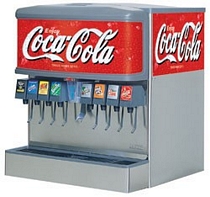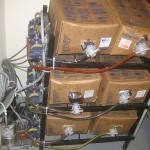Secret to why McDonald’s Coke Tastes Best
 Everyone who sells Coca-Cola fountain drinks uses the same syrup and fountain machines but McDonald’s tastes better. Learn McDonald’s impossible innovation.
Everyone who sells Coca-Cola fountain drinks uses the same syrup and fountain machines but McDonald’s tastes better. Learn McDonald’s impossible innovation.
 If you’ve ever bought a Coca-Cola from a gas station soda fountain you’ve probably noticed it doesn’t taste the same as Coca-Cola from McDonald’s. You might have noticed that a Coke from other restaurants also don’t taste the same. If you look at how Coca-Cola controls every aspect from the syrup to the fountain machine you probably wonder why it doesn’t taste exactly the same everywhere.
If you’ve ever bought a Coca-Cola from a gas station soda fountain you’ve probably noticed it doesn’t taste the same as Coca-Cola from McDonald’s. You might have noticed that a Coke from other restaurants also don’t taste the same. If you look at how Coca-Cola controls every aspect from the syrup to the fountain machine you probably wonder why it doesn’t taste exactly the same everywhere.
If you are like most people, you agree Coca-Cola from McDonald’s tastes better than anywhere else. It’s hard to describe the exact way it tastes better but it certainly does. Moreover, it consistently tastes better at every McDonald’s.
What is McDonald’s the secret?
One of steps of Predictive Innovation® is to list the objects for a scenario. In the scenario of making Coca-Cola fountain drinks the objects are:
- water
- syrup
- CO2
- ratio of ingredients
- mix of ingredients
- temperature
Objects
Of all those objects, McDonald’s can only control two of them. The rest of the objects are controlled by Coca-Cola or the customers. The two things McDonald’s can control are their water and the freshness of the syrup. CO2 is a standard gas that makes the drink fizzy. The ratio of ingredients and the mix of ingredients is controlled by the fountain machine and that is set by Coca-Cola. Customers can change the temperature by adding ice. Water and freshness of syrup are the secret of McDonald’s fountain drink innovation.
Water
Water is 85% of a fountain drink. If the water is bad you will taste it. Like everything else McDonald’s does, they meticulously control their water. Each restaurant has a reverse osmosis filter providing the best water available. This not only makes the Coca-Cola taste better it also makes their coffee taste better. The water you get at McDonald’s is the cleanest anywhere and that is the #1 reason their fountain drinks taste the best.
Syrup
 Most Coke retailers get their syrup in a bag box. These bag boxes are small and allow a retailer to provide Coke with a minimal investment.
Most Coke retailers get their syrup in a bag box. These bag boxes are small and allow a retailer to provide Coke with a minimal investment.
 McDonald’s sells a lot of Coke. They sell so much coke that they don’t need to buy the syrup in the small bag box. McDonald’s restaurants can get syrup delivered from a tanker truck and store it in a stainless steel cylinder. Because they sell a lot it doesn’t sit around as long. So the Coke syrup at McDonald’s is fresher than their competitors. Fresher syrup makes better tasting fountain drinks.
McDonald’s sells a lot of Coke. They sell so much coke that they don’t need to buy the syrup in the small bag box. McDonald’s restaurants can get syrup delivered from a tanker truck and store it in a stainless steel cylinder. Because they sell a lot it doesn’t sit around as long. So the Coke syrup at McDonald’s is fresher than their competitors. Fresher syrup makes better tasting fountain drinks.
McDonald’s also controls freshness by cleaning everything daily. Letting syrup sit in hoses and machines allows it to chemically degrade and for bacteria to grow. Keeping everything clean also keeps it fresh and tasting good.
So even though all their competitors have the same basic ingredients that are required to be put together the exact same way, McDonald’s found a way to innovate and provide a better product.
Action Items
- What are the objects in your product or process?
- How can you change an object to innovate?
How to Solve Impossible Problems
I love impossible problems. Am I insane? That is hotly debated. But the reason I love impossible problems is there are so many possible innovations in every impossible problem. In fact there are at least 225 possible solutions to most seemingly impossible problems.
That’s a lot of innovation.
Very little is truly impossible. Most seemingly impossible problems result from assumptions that hide the solutions. The typical impossible problem is the result of two competing goals. If you improve one feature the other suffers. The goals compete. You want to improve both but can’t so it seems impossible.
How do you solve impossible problems? Break the problem in two and solve each part separately.
For instance electric vehicles solve a lot of problems. Electric cars are very efficient and don’t produce any point of use toxic emissions. The problem with electric cars is they can’t drive very far on a single charge.
Even with a lot of improvements in battery technology electric cars just haven’t gained the type of range most people would like. Recharging takes a long time so an electric car isn’t good for long trips.
How do we solve it? Break the problem in two and solve separately.
The goals are low point of use toxic emissions, and long range. If we break out long range we can solve that a number of ways.
Read more



 Predictive Innovation Training
Predictive Innovation Training Predictive Innovation: Core Skills Book
Predictive Innovation: Core Skills Book RoundSquareTriangle.com
RoundSquareTriangle.com